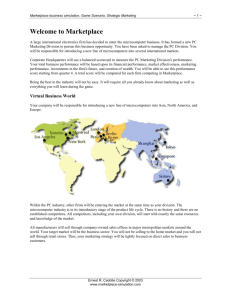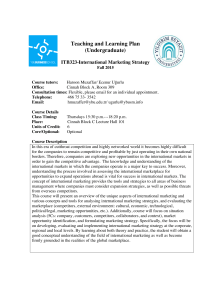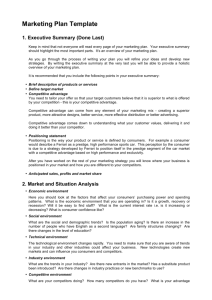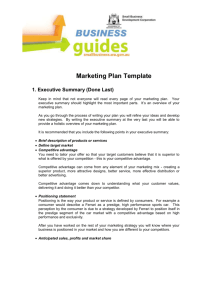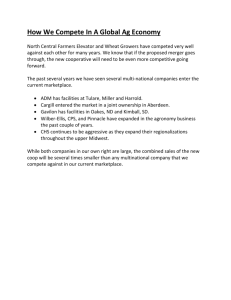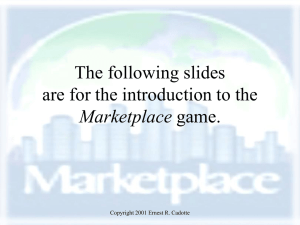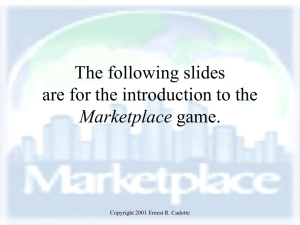Marketplace business simulation, Game Scenario, Venture Strategy
advertisement
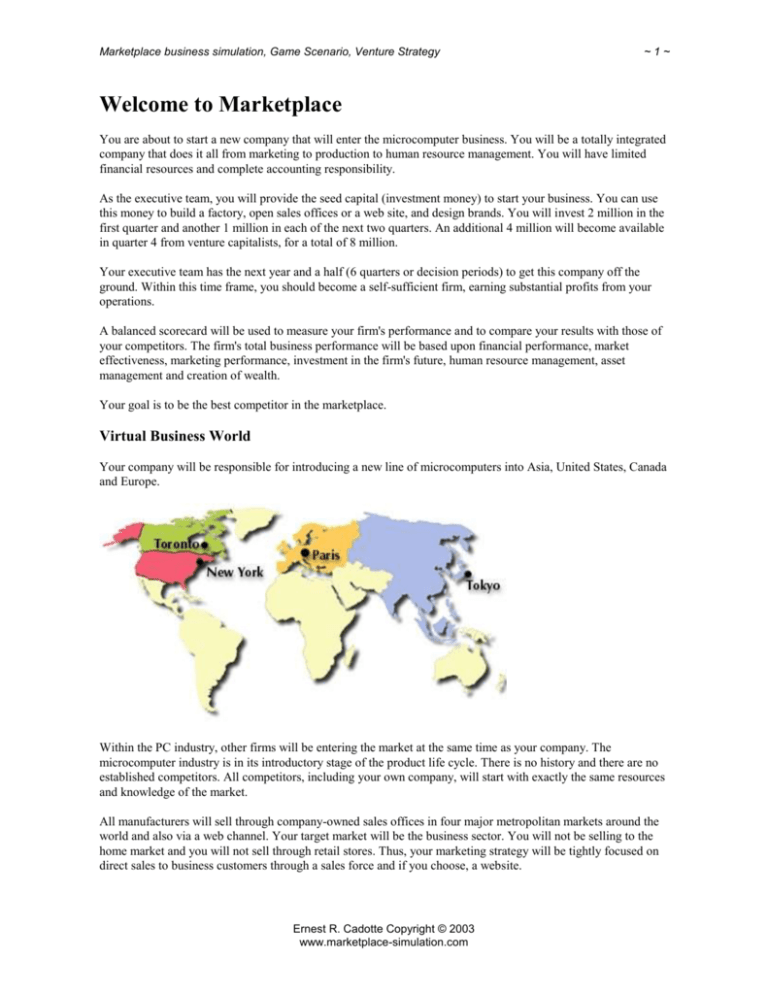
Marketplace business simulation, Game Scenario, Venture Strategy ~1~ Welcome to Marketplace You are about to start a new company that will enter the microcomputer business. You will be a totally integrated company that does it all from marketing to production to human resource management. You will have limited financial resources and complete accounting responsibility. As the executive team, you will provide the seed capital (investment money) to start your business. You can use this money to build a factory, open sales offices or a web site, and design brands. You will invest 2 million in the first quarter and another 1 million in each of the next two quarters. An additional 4 million will become available in quarter 4 from venture capitalists, for a total of 8 million. Your executive team has the next year and a half (6 quarters or decision periods) to get this company off the ground. Within this time frame, you should become a self-sufficient firm, earning substantial profits from your operations. A balanced scorecard will be used to measure your firm's performance and to compare your results with those of your competitors. The firm's total business performance will be based upon financial performance, market effectiveness, marketing performance, investment in the firm's future, human resource management, asset management and creation of wealth. Your goal is to be the best competitor in the marketplace. Virtual Business World Your company will be responsible for introducing a new line of microcomputers into Asia, United States, Canada and Europe. Within the PC industry, other firms will be entering the market at the same time as your company. The microcomputer industry is in its introductory stage of the product life cycle. There is no history and there are no established competitors. All competitors, including your own company, will start with exactly the same resources and knowledge of the market. All manufacturers will sell through company-owned sales offices in four major metropolitan markets around the world and also via a web channel. Your target market will be the business sector. You will not be selling to the home market and you will not sell through retail stores. Thus, your marketing strategy will be tightly focused on direct sales to business customers through a sales force and if you choose, a website. Ernest R. Cadotte Copyright © 2003 www.marketplace-simulation.com Marketplace business simulation, Game Scenario, Venture Strategy ~2~ There are three market segments to serve in the PC market. They are referred to as the Mercedes, Workhorse, and Traveler segments. The Mercedes segment is looking for a high performance computer to use in engineering and manufacturing applications. Mercedes customers are willing to pay extra for the high performance. The Workhorse segment is the largest group of customers. They want an easy to use PC for office workers. It should also have a modest price. The Traveler segment wants a practical computer to use on the road. Traveler customers are executives and sales people who travel a great deal. This segment is also price sensitive. The three segments are portrayed in the accompanying graph. The circles are positioned to indicate the price and performance requirements of each segment. The size of the segment is portrayed by the size of the circle. Each segment has different needs and wants and requires a different market strategy to appeal to it. One of your first decisions will be to select two market segments to target. Having selected your target markets, you will develop and then execute a very focused strategy to profitably serve each segment. How to Succeed How to Win in the Marketplace The formula for success in business and marketing is very simple: Make a lot of people happy and you can earn a lot of money. Here are the rules: A. Find out what people want (market research) B. Give them what they want (product design) C. Tell them you have what they want (advertising) D. Go to where they work and live and personally explain how you have the solution to their needs (distribution) E. Collect the money for a job well done (price). Sounds easy, right? Of course, there are a couple of things that get in the way. First, not all customers are alike. People have different tastes, preferences, and needs. One offer will not work for everyone. As a result, many potential customers will wait until they find the "right" solution for their needs. To paraphrase a famous quote, you can satisfy some of the people all of the time, but never all of the people all of the time. So, demand may not be as great as you would like. The way around this problem is to discover the differences in needs among your customers (market research), break the customers down into smaller groups with similar needs (segmentation), and then develop a strategy for each group (target marketing). Ernest R. Cadotte Copyright © 2003 www.marketplace-simulation.com Marketplace business simulation, Game Scenario, Venture Strategy ~3~ Another challenge is that everyone wants more for less. Sure, you would like to sell for less, but you have to pay your expenses and earn a profit. One solution to this pricing dilemma is larger sales volumes, which result in lower cost per unit. Lower costs will allow you to lower your prices and/or increase your profits. How do you create larger sales volumes? Offer a better product at a better price and tell everyone about it (advertising and sales channel). You will always find that someone wants to make money in the same market as you. Competitors will emerge and try to take your sales and profits. How will they do this? Smart competitors will study customers' needs and what you have to offer (benchmark) and then create and sell something better. Usually, they find a group (segment) whose needs are not met and develop a superior strategy targeted at that group. Customers will almost always gravitate towards the better offer. Your job is never done: you must always check your offer against the customers' evolving needs (satisfaction level) and competitors' offerings (benchmark) to make sure you have the better product, price, promotion, and sales channel. In a nutshell, be the best at creating what customers want, finding the customers, and telling them how good you are at meeting their needs. This should create lots of sales, drive down your costs, and thus allow you to offer good prices with good profits. Of course, success is not this easy, but this is the essence of marketing. Keep these guidelines in mind as you compete in Marketplace. If you follow them, you will be successful. You will be a winner in Marketplace! Good luck! Ernest R. Cadotte Copyright © 2003 www.marketplace-simulation.com
